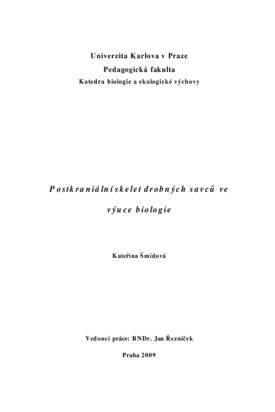Postkraniální skelet drobných savců ve výuce biologie
Postcranial skeleton of small mammals in biology education
diplomová práce (OBHÁJENO)

Zobrazit/
Trvalý odkaz
http://hdl.handle.net/20.500.11956/22821Identifikátory
SIS: 71130
Kolekce
- Kvalifikační práce [19344]
Autor
Vedoucí práce
Oponent práce
Mourek, Jan
Fakulta / součást
Pedagogická fakulta
Obor
Učitelství všeobecně vzdělávacích předmětů pro základní školy a střední školy - biologie - Učitelství pro 2. stupeň základní školy - chemie
Katedra / ústav / klinika
Katedra biologie a environmentálních studií
Datum obhajoby
1. 6. 2009
Nakladatel
Univerzita Karlova, Pedagogická fakultaJazyk
Čeština
Známka
Výborně
Diplomová práce se zabývá možnostmi identifikace drobných hlodavců ve vývržku kalouse ušatého (Asio otus) podle pánevních kostí a postkraniálního skeletu ve výuce biologie. První část textu shrnuje teoretické poznatky, týkající se postkraniálního skeletu, lebek a sovích vývržků, z nichž pak vychází navrhované aktivity. V metodice jsou popsány způsoby sběru a preparace sovích vývržků a následné úpravy vypreparovaných osteologických fragmentů. Dále je uveden přehled a procentuální zastoupení druhů zjištěných rozborem a klíč k jejich určení. Výstupem práce jsou čtyři vyučovací jednotky. Autorka je úspěšně odzkoušela s žáky čtyřletého a osmiletého gymnázia.
This master thesis demonstrates feasibility of identification of small rodents in the pellets of Long-eared Owl {Asio otus) using pelvic bones and postcranial skeleton in biology classes. The first part of the text summarizes theoretical information on mammalian skeleton and owl pellets with in-class activities suggested. The methodology chapter describes methods of owl pellets collection and preparation, and subsequent processing of osteologic fragments extracted from the pellets. A list and relative distribution of small rodent species found during the analysis are included as well as a key for identification of small rodents using skeleton tragments. The outcome of the thesis are four teaching units that were successfully tested by the author on students from eight- and four-year Grammar Schools.
